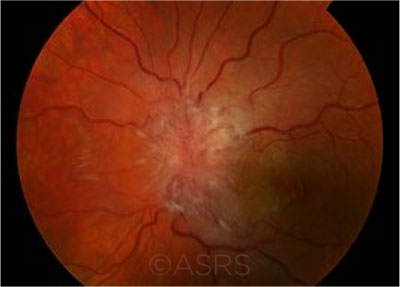Download PDF
British researchers have documented a sharp uptick in the number of cases of idiopathic intracranial hypertension (IIH) in England—and a concomitant rise in the costs of treatment.1
From Jan. 1, 2002, to Dec. 31, 2016, the incidence of IIH rose by 108%, and the number of hospital visits soared by 442%, the researchers found. “The overwhelming increase in patients diagnosed with IIH, and the amount of hospital visits over the study period, was surprising,” said Susan P. Mollan, MBChB, FRCOphth, at University Hospitals Birmingham in the United Kingdom.
What sparked the study? “We had been tasked by the Association of British Neurologists to set up a special interest group that was multiprofessional to write practical guidelines on the management of IIH.2 But there was little data showing the demographic shifts and [documenting] how patients were accessing care,” Dr. Mollan said.
 |
PAPILLEDEMA. Severe papilledema secondary to IIH in a young woman. This image was originally published in the ASRS Retina Image Bank. Suber S. Huang, MD, MBA. Papilledema. Retina Image Bank. 2012; Image Number 828. © The American Society of Retina Specialists.
|
Findings. Dr. Mollan and her colleagues extracted data on hospital activity in England. After applying exclusion criteria, they confirmed that 23,182 new cases of IIH were diagnosed from 2002-2016, with an incidence of 2.26 per 100,000 in 2002, rising to 4.69 per 100,000 in 2016. The overall incidence was higher in women (7.7 per 100,000) than in men (1.6 per 100,000).
Treatment. Hospital admissions rose from 1,315 per year in 2002 to 7,123 per year in 2016. More than half the study cohort had a single hospital episode and no additional hospital care in the year following diagnosis. However, 37.8% had repeat hospital activity. Most patients (91.6%) were managed medically; 7.6% had a shunt procedure; 0.68% underwent bariatric surgery; and 0.07% underwent optic nerve sheath fenestration.
Costs. The cost of IIH-related hospital care climbed from £9.2 million to £49.9 million during the study period—and the researchers estimated that, if this trend continues, the cost will total £462.7 million in 2030.
More surprises. The researchers uncovered two additional surprises: For the first time, IIH in adults was associated with poverty and adverse obstetric outcomes. More than half of cases occurred in socioeconomically deprived areas, and pregnant women with IIH were more likely to undergo cesarean sections compared to pregnant women in the general population.
Wake-up call. Overall, the results confirm that the newly developed guidelines2 are needed, Dr. Mollan said. “Better strategies for these patients are required when they access emergency care.”
—Jean Shaw
___________________________
1 Mollan SP et al. Eye. Published online Oct. 24, 2018.
2 Mollan SP et al. J Neurol Neurosurg Psychiatry. 2018;89(10):1088-1100.
___________________________
Relevant financial disclosures—Dr. Mollan: None.
For full disclosures and the disclosure key, see below.
Full Financial Disclosures
Dr. Jaffe AbbVie: C; Alcon: C; EyePoint Pharmaceuticals: C; Heidelberg Engineering: C; Neurotech USA: C; Novartis: C.
Dr. Jain None.
Dr. Merle Bausch + Lomb: C; Laboratoires Théa: S.
Dr. Mollan None.
Dr. Pearce None.
Disclosure Category
|
Code
|
Description
|
| Consultant/Advisor |
C |
Consultant fee, paid advisory boards, or fees for attending a meeting. |
| Employee |
E |
Employed by a commercial company. |
| Speakers bureau |
L |
Lecture fees or honoraria, travel fees or reimbursements when speaking at the invitation of a commercial company. |
| Equity owner |
O |
Equity ownership/stock options in publicly or privately traded firms, excluding mutual funds. |
| Patents/Royalty |
P |
Patents and/or royalties for intellectual property. |
| Grant support |
S |
Grant support or other financial support to the investigator from all sources, including research support from government agencies (e.g., NIH), foundations, device manufacturers, and/or pharmaceutical companies. |
|
More from this month’s News in Review